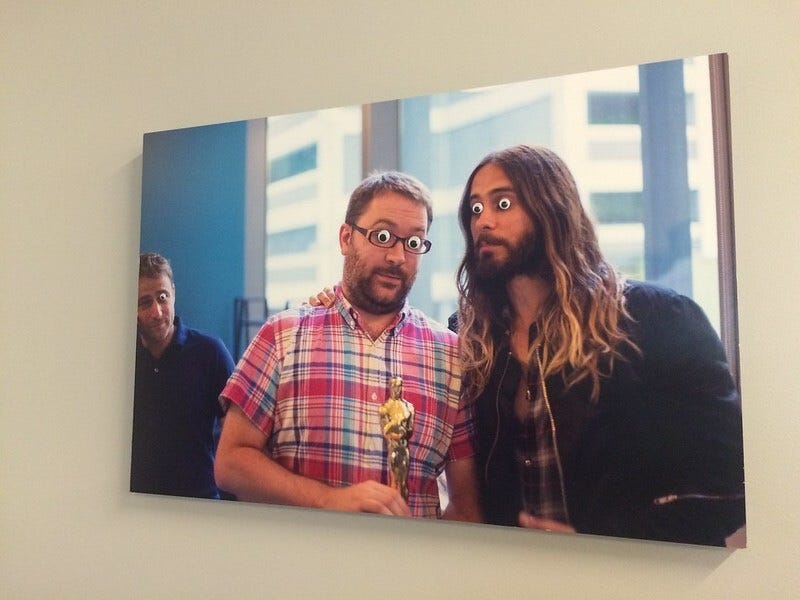Do the Best Work of Your Life
What matters? How do we do things here? Starting to build a sales team culture. Finding a Slack culture.
Hello, nice to meet you. I understand you are seeking a job at Slack. Do you have any questions to get us started?
Yes! The candidates I interviewed almost always did. And the most common question was pretty simple: What’s it like working at Slack?

The people asking had almost always heard about Slack through press reports, blog posts, maybe using the product. So their impressions were pretty positive and glowing, like our press coverage. To a very small group of tech nerds and tech enthusiasts, we were hot. Even kinda famous.
To answer their question, I cribbed from something Stewart said one day: The expectation at Slack is that you’ll do the best work of your life here. We’ll do everything we can do to support you. And we’ll challenge you to do the best work of your life.
That almost always got a small reaction from candidates. Then, as it sunk in, they tended to either absorb that standard, or to set up defences. Those who absorbed it with curiosity tended to move ahead in our process. Those who started to set up defences — How will you know? Is that something you can know? How do you measure that? — didn’t tend to move ahead.
Was the expectation to do the best work of your life a test of faith in both Slack and in a candidate’s own self belief? In their ability to be energized by a big challenge? Looking back, I’d say so.
Hearing a challenge like, “we expect you to do the best work of your life,” either got you excited or made you afraid. And both could also be true each time too, and mostly were. I think it ended up more a question that revealed the default-optimist or default-pessimist setting in people. Optimists wanted the challenge because they could see all the things that could go right. Pessimists could see all the things that could go wrong.
“Do the best work of your life” sounded grandiose and self important. Who were we, a small software company of maybe a hundred people, to set that as the standard? To ask that of people?
And, at the same time, why not us? Why not set that as the standard? If that’s what we intended to do, why not seek like-minded others? If we ended up getting anywhere close to our standard, we’d end up in a very good place.
Internally, we had started to definitely feel like Slack was going to be the best chance for world-class work in each of our respective careers. I felt a sense throughout Slack that this was it, as good as it could get, and that we wouldn’t have endless chances in our working life to do great work. So we needed to do it here and now.
The challenge of doing the best work of your life also presented a flip side and internal challenge for Slack. The second part of the thing we said: we’ll do everything we can to support you. That was as important as the first part. It challenged those of us at Slack to live up to it, and it declared how we intended to treat our team.
And it also described the place where we all wanted to work. A place where people were genuinely seeking to do their best work. Where we could find each other and trust each other because the default standard was as high as it could be. It was complimentary and inspiring. Everyone pulled together and lifted each other up. No one wanted to let their teammates down.
It also meant we could learn from each other, and the world we worked in was changing so fast we needed to be constantly learning.
A Trinity for Decisions
In our Accounts team, we needed ways to make the challenge of doing the best work of your life into something more concrete for day-to-day work.
One of the key things we had to empower in people proved to be decision making. It would have been too slow for each person to consult someone else on each decision. They needed to decide on things for our customers on behalf of Slack, and keep moving. So they needed to be equipped with a quick and simple way to guide those decisions.
We started with a trinity: 3 questions to help each of us make decisions. The trinity acted as a little mental shortcut that led to the right thing to do in almost all situations. So here it is.
When faced with a situation, I wanted the team to ask, in the following order:
What’s best for the customer?
What’s best for the team?
What’s best for me?
So, for example, if a customer was wondering how many users to upgrade, we advised them on the number best for them (likely the smallest number possible based on the fair billing policy rules). Sure, that meant a smaller deal for us immediately. But we trusted our product to work well, retain those users, make them successful and then expand into additional users. And that could mean a bigger deal down the road.
The trinity of questions proven valuable as we started to work on territories and divide up customers among our growing accounts team. It meant no one squabbled about ownership of a customer because what was best for the customer was the first consideration, followed by what was best for the team.
Our trinity questions, in their specific order, struck me as important as a counterbalance against what so often happened in an account management or sales function: the opposite. Too often I had seen What’s best for me? be the first question asked. That felt like it led nowhere near doing the best work of anyone’s life, and it created all kinds of individual optimizations, each person doing first what looked best for themselves.
Using the trinity in order of Customer > Team > Individual provided our team with a hierarchical weighting of priorities for decision making. It also meant that once the team had a little practice they could feel confident knowing their decisions reflected how we wanted things done. And it made them feel good too.
Search First
Another common mental shortcut we used to move fast and keep learning was “search first.” If you have a question, try to figure it out yourself before asking for someone else to help.
Because we used our own Slack product for all our communication, it became like a huge infinite brain for the organization. All of our systems pushed data into Slack, so all of our systems became searchable from in Slack.
If you had a question, chances are good someone else had had the same question before, and chances are good you can answer your own question (or at least get some context) by searching in Slack to find that prior conversation.
Here are some examples of super useful searches our team did daily:
Searching past conversations about customers to find the right levels of credits to provide a new customer — what had worked before?
Finding how when people changed jobs they brought Slack with them to their new organizations and seeing how our spread happened.
Learning about Slack adoption in a specific industry, like healthcare or defence, that meant we could understand a customer’s context and speak in their language.
Wind me up and I can go on for a long time about the bonuses for everyone involved in this self sufficiency and autonomous practice. No one got taxed by another person’s laziness to not seek out their own answer. No one got interrupted. No one was stuck and just waiting for Kim or Mike or AJ to get back to them.
Searching made our team better at using our product, which made them better at teaching customers how to use it. It made them confident and it empowered them to take agency to answer their own questions as a default. It made them unstuck.
I think that appreciating the shift in mindset from ask-first to search-first is essential to understanding how Slack worked internally, as well as how things happened at the forefront of a digital world. No one needed to ask permission. Everyone was responsible for themselves today, and for communicating clearly, in a way that served them and their teammates, tomorrow, when anyone could be searching again.
I also think it created a team dynamic that featured trust in openness and trust in our product and trust in the capabilities of present and future teammates to solve problems. If we were asking people to do the best work of their lives we also wanted to show them how we believed that happened.
When someone did need to go to a boss or co-worked with a question, the expectation was that they would show their work for context. When I needed to know our vacation policy for cancelling requests, I found it, but wasn’t sure it was up to date. I checked the answer I had found with an expert, and showed them what I had found as an answer. It wasn’t up to date so we added in a new, current message that anyone searching later could then find. Future Slack might thank us.
Finding a Slack Culture
For people used to having others answer their questions, doing the work yourself might seem harder.
But zoom out and self serving is actually the easier option, by far. It involves one person, instead of many. Its action is independent, instead of dependent. It matches a question and answer at the source in the same moment. It teaches people they have the power to answer their own questions.
As we grew in number of employees, we had to start really working on what it meant to work at Slack. We drew on many influences to figure out what we wanted to stand for, and what we didn’t abide. We wanted to be able to answer: How do we do things here?

I remember talking with Stewart about how the Golden Rule at Four Seasons Resorts, could be an inspiration for us at Slack. As Four Seasons founder Isadore Sharp says of employees, “If we are going to ask them to make us the best, we had to give them what they needed to rise to that occasion.” For them, that meant anyone — doorman, front desk staff, housekeeping, engineer — could do whatever a situation required to make things right for a guest. That’s what they believed worked for them.
Now we had a chance to put into practice what we believed could work for us, to help people do the best work of their lives. We just had to get down to the messy business of doing it.
Up next — How Slack Built its Culture: Starting with 4 Slack attributes. Becoming 6 Slack values. Creating canonical stories. Onboarding as a force multiplier.



